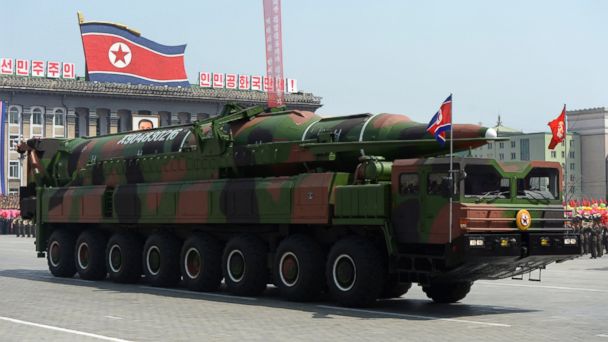North Korea Launches Two Mid-Range Ballistic Missiles

(Pedro Ugarte/AFP/Getty Images)
In a statement, State Department Deputy spokesperson Marie Harf said the United States had confirmed the launch of two Nodong medium range ballistic missiles from North Korea's western coast. The two missiles then traveled more than 400 across eastward across the Korean Peninsula landing in the Sea of Japan.
A spokesperson for NORAD/U.S. Northern Command confirmed that two missiles were fired at approximately 2:30 a.m. local time or 1:30 p.m. ET.
Harf labeled the Nodong launches as "a clear violation" of United Nations Security Council Resolutions that bar North Korea from conducting ballistic missile tests.
She added that in the response to the launches the United States was "closely coordinating" with allies for additional UN Security Council action "to address the threat to global security posed by the DPRK's nuclear and ballistic missile programs."
Harf said two recent SCUD missile launches and Tuesday's No Dong missile launches "represent a troubling and provocative escalation that the United States takes very seriously." She added, "we urge North Korea to exercise restraint and refrain from further threatening actions."
Since Feb. 21, North Korea has also fired several volleys of short-range Soviet-era FROG artillery missiles as well as two SCUD missiles. On Monday, North Korea fired a volley of 30 of the missiles into the sea.
Gen. Curtis Scaparrotti, the commander of U.S. Forces Korea, told a congressional panel today that a small portion of the missile volleys were part of the normal winter training cycle.
The remainder were "demonstrations, both for his regime and for demonstration to the people of capability," Scaparrotti said, referring to North Korean leader Kim Jong Un. He said they were also intended to demonstrate to the U.S. and South Korea what they are capable of doing "on short notice, with very little warning."
North Korea typically conducts provocatory actions around the same time as an annual joint U.S.-South Korean military exercise.
This year's exercise will include a large-scale amphibious landing involving a joint U.S.-South Korean force of 13,000 and 20 ships, military officials said.
In his appearance before the Senate Armed Services Committee, Scaparrotti agreed with an assessment that North Korea is on pace to develop a long-range ballistic missile capability by 2024 that could reach the U.S. homeland.
In 2012, North Korea fired two long-range Unha 3 missile tests that it said were intended to launch a satellite into orbit, but which the U.S. said was a cover for an ICBM test.
Also of concern has been North Korea's development of the KN-08 missile, an intercontinental ballistic missile that is capable of being fired from a mobile launcher and with little warning. Early last year, North Korea played a cat-and-mouse game with the missile, placing it in a launch position several times, though ultimately no launch was carried out.
A U.S. official said Monday that the U.S. had not picked up any indications that North Korea was preparing to launch its long-range missile tests.